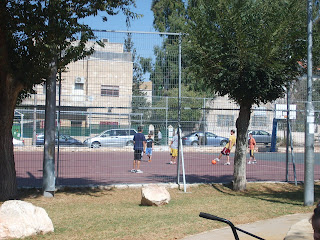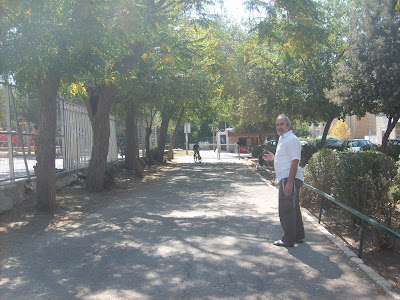 Location: Efraim and Gidon (Gideon) Streets, Baka.
Location: Efraim and Gidon (Gideon) Streets, Baka.Parking: It is still reasonably easy to find on-street parking along Efraim, Gidon and other nearby streets. The shady spots lining the park itself, which until a year or two ago were snaggable at all hours, now tend to be taken up by 8-8:15 am.
Shade: This park is pretty shady, which is one of the reasons I use it regularly. Although not all of the play equipment is in shade at all times, much of it is shaded at any given time. Notably, the swings are in shade during the early afternoon hours -- a problematic time slot for Jerusalem playground-goers who don't want the sun beating down on their heads.

I have taken children here at the unthinkable hour of 1:00 pm on a summer's day, just to use the swings ... And although the slide/climbing structure is in full sun for much of the day, it actually provides shade for the sand pit in which it stands (along with some surrounding trees). The open green space is shaded to some degree at any given hour.
Even the Mom-Mobile (can you guess which one it is?) enjoys the shade.

Playground equipment and features:
-- Large climbing structure with sections suitable for both toddlers/preschoolers:

and older children:

-- Swings (one toddler swing and one older-child swing). The swings are in shade from the late morning into the afternoon.
-- Sandbox. Sandboxes are a dying breed in Jerusalem; you find them only in older playgrounds -- and when such playgrounds are renovated, the sandboxes are generally removed. I guess it's a labor-intensive affair to keep them free of animal droppings, though some appear to stay cleaner than others. The Gan Gidon sandbox unfortunately tends to be dirty and smelly; on one recent Friday morning I simply had to keep my daughter out of it due to its kitty-litter ambience. Usually, though, the situation is tolerable, and in my experience the sandbox in this park is extensively used.
Sandboxes in general are not for the fainthearted mom; even when they look clean I always suspect the worst -- but I steel myself and let my kids play in them because I feel that they provide a valuable kind of sensory stimulation that other playground features/equipment don't offer. They certainly keep my little one occupied for relatively long periods of time.
I just call in the biohazard squad to decontaminate her afterwards.

-- Seesaw
-- Merry-go-round-- Spring toy-- Basketball and soccer court

-- Open green space (smallish), with large rocks for climbing.

-- Picnic tables

-- The shady, tree- and shrubbery-bordered length of sidewalk along the Efraim St. side of the park is really part of the park itself, and is a good area for bicycling/scootering/bimba-ing.

Age range: toddler/preschool, school-age
 Snack factor: A kiosk at the park entrance on Efraim St. sells the usual ice creams/ices, salty snacks, and drinks. The kiosk recently changed hands and now calls itself "Efraim Bar." Previously it was called "Yummy BaPark"(יאמי בפארק) -- a name that never failed to raise a smile on my lips. Beyond this, myriad eateries, groceries/minimarkets and greengrocers are available a block or two away on either Derech Beit Lechem (Bethlehem Rd.) or Emek Refaim St.
Snack factor: A kiosk at the park entrance on Efraim St. sells the usual ice creams/ices, salty snacks, and drinks. The kiosk recently changed hands and now calls itself "Efraim Bar." Previously it was called "Yummy BaPark"(יאמי בפארק) -- a name that never failed to raise a smile on my lips. Beyond this, myriad eateries, groceries/minimarkets and greengrocers are available a block or two away on either Derech Beit Lechem (Bethlehem Rd.) or Emek Refaim St.The back of the kiosk has been "decorated." While I accept that graffiti can be an authentic mode of artistic expression, I'm not too fond of the pink, green and black color scheme here...

 Schmooze factor: Gan Gidon attracts a particularly varied population of veteran Israelis, immigrants, short- and long-term visitors. On fine mornings I often see metaplot (family-based childcare providers) wheeling their young charges into the park in kibbutz-style wagons. I have also struck up conversations with the elegant, slender wives of American journalists stationed in Jerusalem, fresh from their cosmopolitan morning swims at the Y, slumming it with their lone toddlers in the less-than-hygienic sand pit. There are lots of French-speaking immigrants in Baka these days, so you hear that language along with the occasional Russian and ubiquitous English (Hebrew too, sometimes). Altogether Gan Gidon is a sociable little park, situated halfway between two fashionable thoroughfares; a true "third place."
Schmooze factor: Gan Gidon attracts a particularly varied population of veteran Israelis, immigrants, short- and long-term visitors. On fine mornings I often see metaplot (family-based childcare providers) wheeling their young charges into the park in kibbutz-style wagons. I have also struck up conversations with the elegant, slender wives of American journalists stationed in Jerusalem, fresh from their cosmopolitan morning swims at the Y, slumming it with their lone toddlers in the less-than-hygienic sand pit. There are lots of French-speaking immigrants in Baka these days, so you hear that language along with the occasional Russian and ubiquitous English (Hebrew too, sometimes). Altogether Gan Gidon is a sociable little park, situated halfway between two fashionable thoroughfares; a true "third place."Multiple uses within the park: This compact park/playground manages, within its narrow confines, to encompass quite a few different uses that complement each other and enhance the site's value as a family-oriented public space.
-- Play equipment suited to both young and older children
-- A sand pit that constitutes a separate attraction, distinct from the play equipment
-- A basketball and soccer court
-- A lawn that is reasonably shady even in mid-afternoon
-- Picnic tables
-- Shrubbery areas suitable for young children to explore and muck around in
-- Adjacent kiosk (with seating) that fuels additional human interaction.
Bottom line: You can occupy kids here for decent amounts of time, because there are several distinct play areas/activity options. If only the sandbox were cleaner!
Beyond the park: a walk along Gidon (Gideon) St., Baka
Gidon St. provides the urbanista mom with a conveniently direct route between the two chic commercial hubs of Derech Beit Lechem (Bethlehem Rd.) and Emek Refaim St. But Gidon St. is more than just a connecting line. If you take Gan Gidon (Gideon Park) as your starting point, a walk along Gidon St. in either direction offers a kind of classic urban Jerusalem experience, in the form of residential architecture and landscaping that run the gamut in terms of style, period, and socioeconomic context.
The intersection of Gidon and Efraim features an attractive seating area:

Children like to walk around the stone benches surrounding these old olive trees, and (depending on age) to climb the trees themselves.

The lovely flower garden adjacent to the seating area perpetuates the memory of Eli Altretz [sp.?], a painter and sculptor who was murdered by an Arab terrorist in 1990.

Turning eastward up Gidon in the direction of Derech Beit Lechem, one finds interesting old houses ...

... newer residential buildings, and hybrids of the two:

I'm no expert on Jerusalem architecture (that's an education I hope to acquire when I no longer find myself spending large chunks of time in playgrounds), but when I look at the building pictured above I think, Middle East on the bottom, Bauhaus on top.
Another building that incorporates the old into the new:

Too bad the arched windows in the photo below (the same old-new hybrid building as the one pictured above) are mostly hidden by a high, forbidding wall.

Here, one new project offers the passerby a garage-scape to look at ...

... while on the opposite side of the street you can glimpse a beautiful garden through a chain-link fence:

As you approach Derech Beit Lechem, Gidon Street becomes closed to vehicular traffic and narrows to a footpath:

New but tasteful:

The trendiness that is Derech Beit Lechem:


Corner of Derech Beit Lechem and Esther HaMalka St. (one block down from the Derech Beit Lechem-Gidon St. intersection). The yellow awning (if I remember correctly) belongs to Siman Kriah (a.k.a. "Bookmark"), a store that sells used English-language books:

Returning to the Gidon-Efraim intersection:
A sign exhorts us, in one official and one non-official language, to care for Jerusalem's appearance:

Yet just across the intersection, one finds legalized street spam (a.k.a. litter on a stick), courtesy of the Jerusalem Municipality:

The section of Gidon St. that extends from the Efraim St. intersection to Derech HaRakevet is a study in contrasts.
The even-numbered side of the street is the more upscale side, featuring attractive and well-maintained stone buildings. The odd-numbered side consists of shikun buildings (Israeli mass housing of the 1950s and 1960s). Some of the buildings have been refurbished, while others retain their old-style facing:

The location being what it is, even these less upscale buildings have their signs of gentrification, such as sleek and shiny designer doors to individual apartments -- which contrast starkly with internal courtyards that have yet to be gentrified:

The end of Gidon St. is picturesque:


From here you enter Derech HaRakevet, where a new park, featuring attractive greenery, walkways, bicycle and running paths, has tastefully incorporated the old Jerusalem railroad track ...

... proving that the Jerusalem Municipality can plan something right when it wants to. Park HaMesila is a pleasant urban space to cross on the way from Baka to Emek Refaim, and an equally pleasant destination in and of itself, for humans and their canine friends alike.

The new trees have some growing to do before they can give any real shade. During chol hamoed Sukkot, DH and I stood/sat mainly in the sun for half an hour while our three school-aged boys cycled happily up and down Derech HaRakevet:

The building with the arched windows in the background was hidden from view until recently, when the area around it was cleared for a new parking lot. From an urbanist point of view, perhaps this is a net gain.
The vibrant commercial hub of Emek Refaim is just a block down.



























